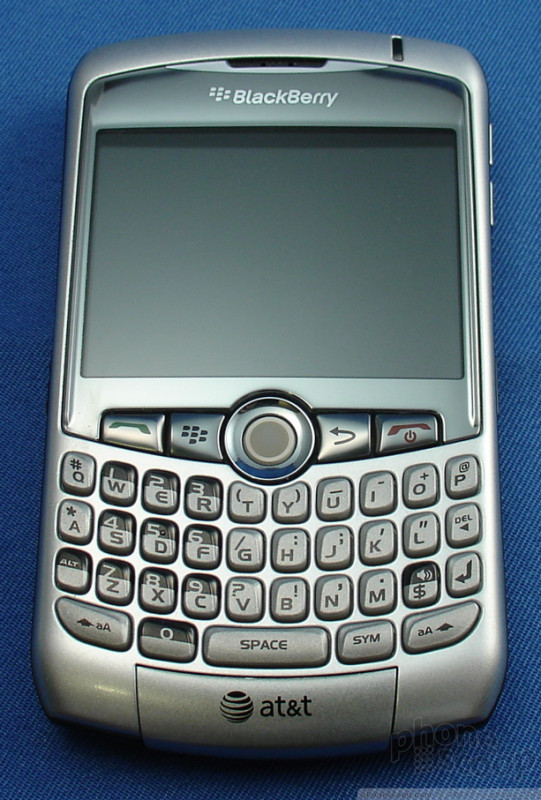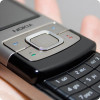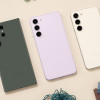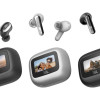Review: BlackBerry Curve
As far as full-QWERTY phones go, the Curve is downright diminutive. It may be larger than the Pearl, but sitting it next to a Treo or just about any other QWERTY device will show you just how small it is. It is the same height as the Pearl, but is wider by about a centimeter and is also thicker by a few millimeters. This also means it is heavier. Where the size difference is most noticeable is with the improved usability of the keyboard and screen.
Holding the Curve in your hand is remarkably comfortable. Many QWERTY smartphones suffer from extreme width, making them somewhat awkward to grip. Because the Curve is still fairly thin, it slides into your hand easily. The weight is nice - it's solid and balanced. Gripping it at the bottom for two-handed typing is comfortable. The front and back are made from gray plastic, but the sides have a black, soft-touch paint job that makes the Curve stick in your hand nicely. There is no fear of the Curve slipping from your hand.
The screen size is generous. It provides a lot of real estate for viewing the Curve's menus, reading emails and interacting with the phone. Using the Curve's keyboard is an entirely different experience than the Pearl's. Where the Pearl has mushy, soft-feeling keys that were smooshed together, the Curve's keys resemble those of the Treo in that they are hard little nubs protruding from the surface of the phone. The Curve's keyboard is slightly wider than the Treo's (by 1/8 of an inch) and this makes all the difference in the world with respect to usability. Each key is squarish and provides just the right amount of feedback to let you know you've pressed it. Having a full QWERTY keyboard that works makes for faster emails and SMS's.
The one hiccup we found is that our left thumb kept accidentally fat-fingering the "alt" key when reaching for the "A", which left us with more asterisks in our emails than we cared for. And of course, the tiny keys means punching in phone numbers can be a bit of a chore. This is an affliction that most QWERTY-equipped smartphones share.
Another change from the Pearl is the Pearl's namesake: the track ball. The track ball on the Pearl protrudes a bit from the phone itself. It sticks up a millimeter or two from the surface of the phone. This left it exposed to snags and was often a failure point for the Pearl. Not so on the Curve. RIM's engineers embedded the track ball further into the keyboard of the Curve, and it does not protrude nearly as much as the Pearl's track ball. It is flush with the rest of the keys around it. For a seasoned Pearl user, this took some getting used to. It seemed harder to use at first, but eventually I got the hang of it. You can adjust the track ball's sensitivity to suit your own tastes. Overall, using the track ball is far more intuitive than the side-wheel design of previous generations of BlackBerries. The ability to move the selector in any direction on the Curve makes for faster navigating around the screen. It is also better for left-handed people than the side wheel, which favored righties.
The other function keys on the front of the phone are similar to the Pearl's, but feel a bit different. They are bigger than the Pearl's, but also have a more curved surface. They all had good travel and feedback.
Once you move away from the front of the Curve, it is almost identical to the Pearl. The headphone jack (which is full-sized on the Curve, but 2.5mm on the Pearl), USB chargeport and application key are placed in the same spots on the left side of the Curve as they are on the Pearl, and the volume rocker and secondary application key are in the same spots on the right when compared to the Pearl. The application key on the left side of the Curve has three rubber nubs, making it easy to find. It provides a nice clicking action. The keys on the right side are less usable. Rather than rubber, they are made of silvery-plastic. The application key on the right side of the Curve is recessed just the tiniest fraction from the surface of the Curve, making it somewhat difficult to locate and press. The volume rocker above it is better in that it is raised above the surface of the phone, and the action is nicer.
Removing the battery cover is a snap, though the SIM card and microSD card slots are located under the battery. This means no hot-swapping (which is a bummer, because the Curve takes forever to reboot).














 Summer 2007
Summer 2007
 iPhone 15 Series Goes All-In on USB-C and Dynamic Island
iPhone 15 Series Goes All-In on USB-C and Dynamic Island
 Samsung Puts its Best Camera Yet in the Galaxy S23 Ultra
Samsung Puts its Best Camera Yet in the Galaxy S23 Ultra
 JBL Brings Smart Charging Case to More Earbud Styles
JBL Brings Smart Charging Case to More Earbud Styles
 Snapdragon 6 Gen 4 Brings More AI to Mid-Range Phones
Snapdragon 6 Gen 4 Brings More AI to Mid-Range Phones
 BlackBerry Curve 8300
BlackBerry Curve 8300


